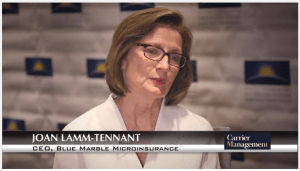

Joan Lamm-Tennant, CEO of Blue Marble Microinsurance and author of the accompanying article, “Building a New Business Model at Blue Marble Microinsurance, spoke to Carrier Management about microinsurance and the company during a videotaped interview at the IICF Women in Insurance Global Conference in June. Excerpts of the interview are presented below.
 What is microinsurance?
What is microinsurance?
Lamm-Tennant: Microinsurance is risk protection for the poor—artisans, small-scale farmers, shop owners. We address their specific risk protection needs and enable them to have stable consumption, which allows them to invest, improve productivity and grow through the economic pyramid.
What are the greatest benefits for carriers that take part in the microinsurance consortium?
Lamm-Tennant: It’s an opportunity to have an impact, to be relevant, to work in public-private partnerships and solve the protection gap. By solving the protection gap and being a part of the financial inclusion initiatives, we enable a massive emerging middle class…
Today, we have seven billion people in the world. The middle class is only 1.8 billion.
We could double that in the next 15 years.
The opportunity is also significant in terms of solving our own problems within the insurance industry. It’s an opportunity to be forced to innovate because being successful in these markets is not about lifting and shifting products that are on our shelves. It’s about being more efficient, being more focused on the value proposition within our products, and it’s about new distribution channels.
Because we’re forced to innovate, we’ll have the opportunity to reverse innovate.
Last of all, we have a talent challenge within the insurance industry. The millennials are not necessarily interested in investing their brilliance, their talent, in our causes. So this is a way in which we join them in their cause for relevancy.
Exactly how does the collaboration work? How do carriers share the costs, premiums and claims? Whose paper are policies written on?
Lamm-Tennant: We’re a service entity. Our objective is to prepare a complete turnkey, cost-efficient package for the carriers so that they can enter the market…
What are the component parts of that package? It could be everything from policy design to distribution mechanisms to social impact metrics. In essence, by delivering this package to the carriers, they then will have to add risk capital, using this enabler to enter the market. Their goal is to create the market.
Yes, one of them will lead, and that’s a part of our governance structure. Collectively, among the eight carriers, we have licenses in many markets. A lead, perhaps, would be somebody who is already present with a license…Within and among the eight of us, to fill the demand, our goal is to engage local carriers and other partners. [What] we’re trying to do is make it cost efficient, by sharing the development cost, so that they can enter with risk capital at a profitable level.
In what areas do you expect microinsurance carrier participants to innovate and reverse innovate?
Lamm-Tennant: Success will not occur by simply reducing a few zeros off the line and saying, “Here, we’ve made this a smaller product. So won’t you buy it?” We have to innovate in terms of the product being linked directly to the inhibitor. It has to have a clear value statement.
We talk about insurance being sold and not bought. That’s because our value statement isn’t clear. So that’s the first part.
The second part is our distribution mechanisms have to be efficient. I’m not suggesting abandonment of the agency distribution system, [but the question is] how do we enable that system to be very efficient with technology.
The third is how we measure success…If we truly want to be relevant, let’s put some broad measures of social impact in our products and not carve it off into a CSR initiative.
Those are three platforms that are going to be critical to our success and create an opportunity for the carriers to then rethink similar issues in their traditional business.
How are microinsurance products distributed?
Lamm-Tennant: We’ve seen some success in some markets with the distribution through utility companies, mobile phone operators, even seed manufacturers. [But] the embedded distribution costs are quite high…Some of these products distributed on those platforms could have a claims ratio of 10 or 20 and a distribution cost of 50 or 60. So we can’t just roll ourselves into those platforms.
We have to think about how to utilize those platforms yet still do it in an efficient way and not impose such distribution costs. Having said that, we are an arm’s throw away. It is within our reach that the poor will move from mobile phones to smartphones…
How can insurers educate potential customers and create demand?
Lamm-Tennant: Research today shows that game playing can be very effective. But it can also be very costly…Any one of those games costs $68 to execute by one estimate. That’s a big cost.
This brings me back to the smartphone. How many of us play games on smartphones and their simple little apps? We’re going to be looking at a way of distributing education via games, which we know is very successful, but doing it in a way that’s affordable.
How will you measure the success of the venture?
Lamm-Tennant: Success to us is having demonstrated evidence that those who are benefitting from our products are benefitting in a sense that they are moving up the economic pyramid—that we’re seeing behavioral change. We’re seeing them put risk aside and invest in their businesses, grow their land, sustain their consumption if it’s a food sustainability motive that we’re looking at.
Complete interviews are available on the Carrier Management channel at www.insurancejournal.tv/